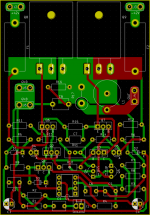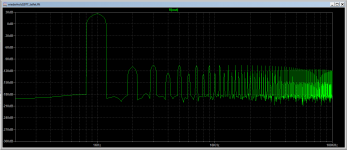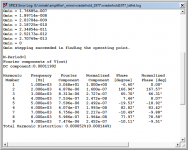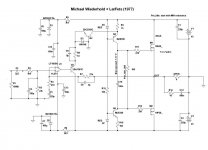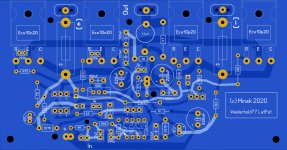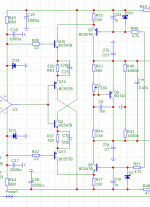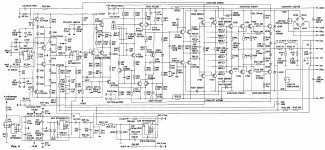Here is the corrected version, hope this is OK now.
I don't have either of these parts, I will have to order them anyway once done with the PCB.
Instead of GT308, you can use GT322 or AG128
Вместо ГТ308 можно использовать ГТ322 или AG128
I don't have either of these parts, I will have to order them anyway once done with the PCB.
Attachments
Instead of GT308, you can use GT322 or AG128
Вместо ГТ308 можно использовать ГТ322 или AG128
You mean AC128 ?
GT322 has 4 pins, I guess one of them is ground?
Here is the corrected version, hope this is OK now.
I don't have either of these parts, I will have to order them anyway once done with the PCB.
Q6/Q7 will be mounted on small heatsink(s) - like in my photos.
The size of my small heatsink was adequate, but it wouldn't hurt making it little bit bigger,
so you may want to plan this ahead of finalizing the PCB.
E.g. this coil sitting right in front of Q7, may be obstructive, if you have to screw/unscrew the bolt for the heatsink.
Last edited:
Instead of GT308, you can use GT322 or AG128
Вместо ГТ308 можно использовать ГТ322 или AG128
If it is AC128 as minek guessed, I might be able to fond this locally.
For Q1 and drivers, these Toshiba transistors also can be used:
TTC004B (npn)/TTA004B (pnp)
These are very good transistors, available from Digikey and Mouser.
I suspect drivers can also be MJEs, but haven't tried it.
I further suspect, even Q1 can be MJE 🙂 They are all fine in sim.
According to original article in Russian, the germanium transistor can be pretty much any low-power, high-frequency germanium transistor. They usually have
low beta (< 100).
E.g. American transistors 2N1854 or 2N2048 will be good too.
I have 2N1854 and was thinking to use them, but finally decided to stay true to the Russian original 🙂
Also GT308B looks more robust and stronger..
TTC004B (npn)/TTA004B (pnp)
These are very good transistors, available from Digikey and Mouser.
I suspect drivers can also be MJEs, but haven't tried it.
I further suspect, even Q1 can be MJE 🙂 They are all fine in sim.
According to original article in Russian, the germanium transistor can be pretty much any low-power, high-frequency germanium transistor. They usually have
low beta (< 100).
E.g. American transistors 2N1854 or 2N2048 will be good too.
I have 2N1854 and was thinking to use them, but finally decided to stay true to the Russian original 🙂
Also GT308B looks more robust and stronger..
Last edited:
Replace the Alison/Akulinichev current shunt with the usual thermal stabilization circuit and add a cascade with OK to the input.It will be much better
Wiederhold 1977 amp
Now going back to the grandfather of the Lomakin & Parshin amp:
original design from 1977 by Michael Wiederhold - already mentioned in post #25.
Original article from German "Radio Fernsehen Elektronik" zipped and attached. The same design was one year later published in Russian "Radio", and in Czechoslovakian "Ameterske Radio".
I tested several variations of Wiederhold amp in Ltspice:
BJT, Quasi, Hexfet, Latfet (Latfet version ASC file attached).
Here is Latfet version - the simplest one, yet it gives excellent results. I'm working on the prototype right now, and will post updates here.
Next version to be built after Latfet - Hexfet quasi 🙂
I have too many N-Channel power mosfets in my drawers..
Now going back to the grandfather of the Lomakin & Parshin amp:
original design from 1977 by Michael Wiederhold - already mentioned in post #25.
Original article from German "Radio Fernsehen Elektronik" zipped and attached. The same design was one year later published in Russian "Radio", and in Czechoslovakian "Ameterske Radio".
I tested several variations of Wiederhold amp in Ltspice:
BJT, Quasi, Hexfet, Latfet (Latfet version ASC file attached).
Here is Latfet version - the simplest one, yet it gives excellent results. I'm working on the prototype right now, and will post updates here.
Next version to be built after Latfet - Hexfet quasi 🙂
I have too many N-Channel power mosfets in my drawers..
Attachments
Minek! Add bias (two diodes) to base Q2? Reverse diode BE Q1. Diode protection can be retained.
Last edited:
Sukhov Amplifier
Hi Stanislav,
I look at his amplifier and wonder whether making it fully symmetrical would bring a simple and possibly effective improvement in performance? It seems a shame not to, to my mind 🙂
Edit: wonder if this topology would lend itself to an NDFL scheme?
Paul
Last edited:
Exactly like that!
Does it perform any better?
I’m an LTSpice man. Going to fire this schematic into this tomorrow. Then I can have a play. The rush cascode part does make nested feedback an option even just as a technical exercise. As you can guess nested feedback has my interest at present.
Does it perform any better?
I’m an LTSpice man. Going to fire this schematic into this tomorrow. Then I can have a play. The rush cascode part does make nested feedback an option even just as a technical exercise. As you can guess nested feedback has my interest at present.
An article in the magazine Radio.
Unfortunately only in Russian
К сожалению только на русском языке
Unfortunately only in Russian
К сожалению только на русском языке
Attachments
Last edited:
Exactly like that!
Does it perform any better?
Then I can have a play. The rush cascode part does make nested feedback an option even just as a technical exercise. As you can guess nested feedback has my interest at present.
There are no nested feedbacks in this scheme
Last edited:
Thank you. Hopefully, in today’s Information Age Some sort of rough translation to English is possible. I like this sukhov amplifier.
No nesting in this scheme but it does start to look like the compensation in the PGP amplifier could be grafted on.
PGP Amplifier
In effect a simplified PGP.
No nesting in this scheme but it does start to look like the compensation in the PGP amplifier could be grafted on.
PGP Amplifier
In effect a simplified PGP.
Last edited:
- Home
- Amplifiers
- Solid State
- Unusual amp from 1987
